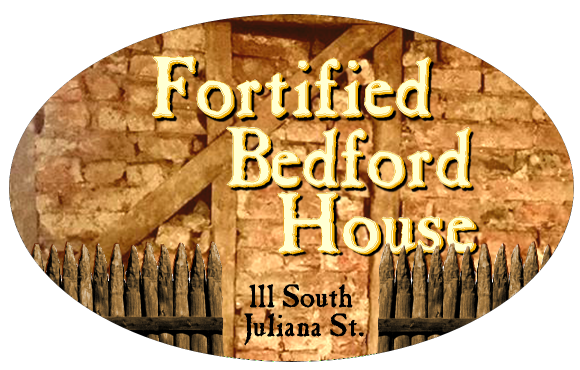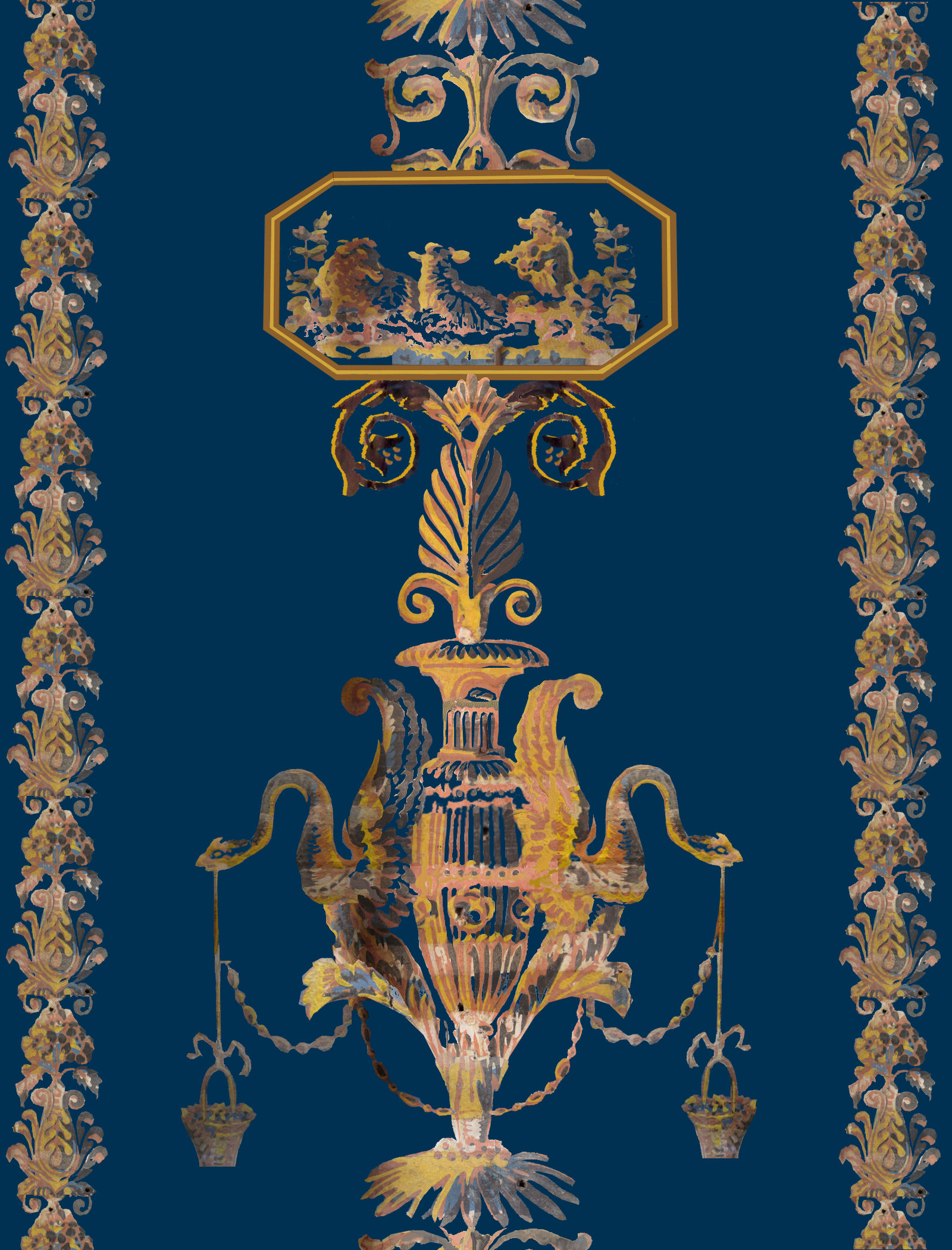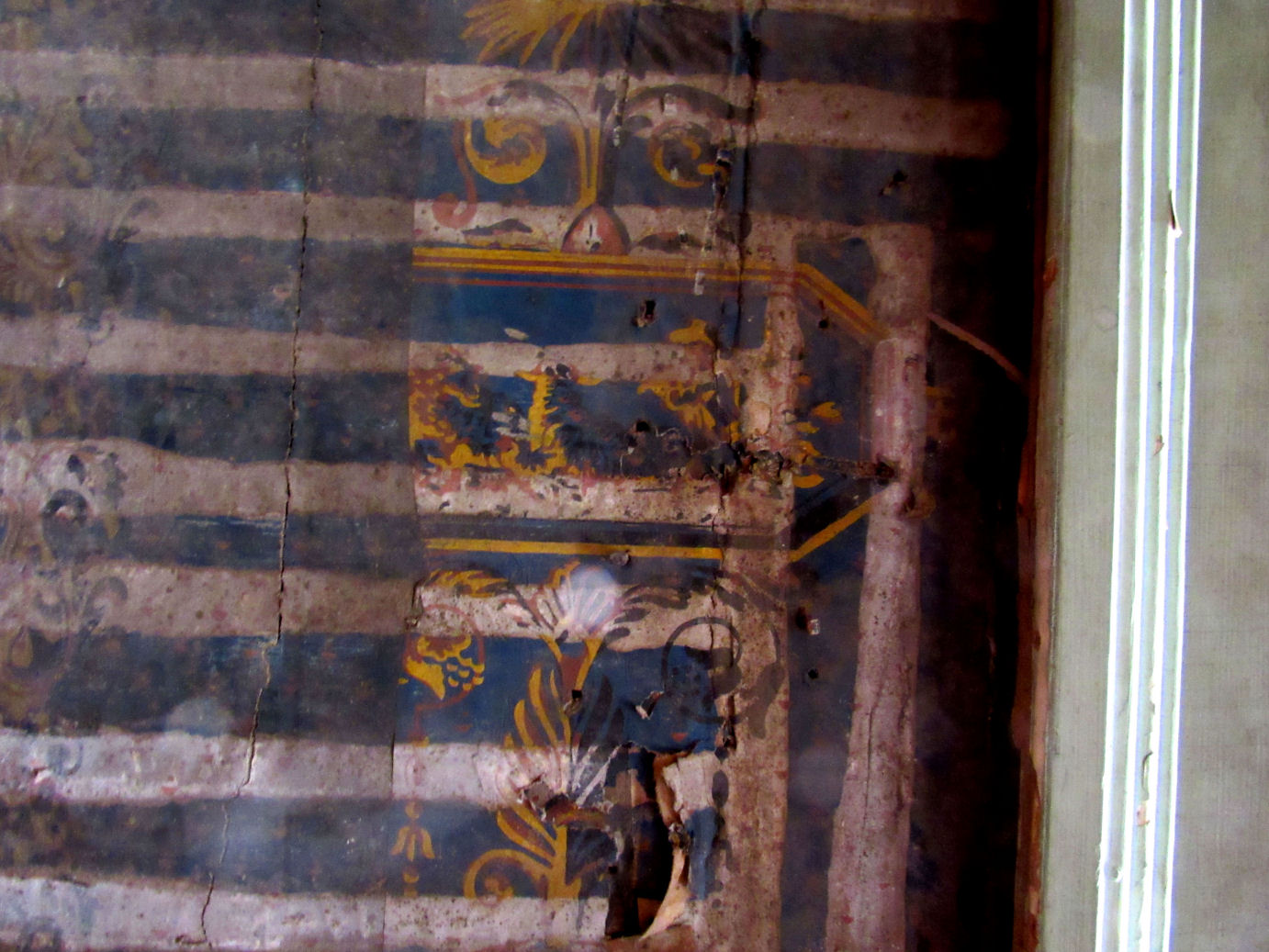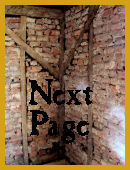
A Gallery of the Fortified Bedford House
The Wallpaper
 The log section of the building, named the 'Sacred Space' by Tyna Walker-Lay, was built abutting the half-timber structure's east end at some time between 1780 and 1810. The building, along with the Commandant's or King's House, was at that time owned by Henry Wertz and his family. While the King's House was operated as the Rising Sun Tavern by Mr. Wertz, the half-timber and log structure was probably used as the dwelling of the Wertz family.
The log section of the building, named the 'Sacred Space' by Tyna Walker-Lay, was built abutting the half-timber structure's east end at some time between 1780 and 1810. The building, along with the Commandant's or King's House, was at that time owned by Henry Wertz and his family. While the King's House was operated as the Rising Sun Tavern by Mr. Wertz, the half-timber and log structure was probably used as the dwelling of the Wertz family.
 Mrs. Wertz no doubt wanted her home to be as 'modern' and elegant as possible. She therefore had certain of the walls covered by wallpaper. The wallpaper she chose to have installed over the beadboard paneling was a solid blue color over which was a gold pattern of a stylized vase with flowers. The gold pattern included a horizontal lozenge shape inside of which was a scene of a shepherd playing a flute to two of his sheep that were lying on the ground nearby.
Mrs. Wertz no doubt wanted her home to be as 'modern' and elegant as possible. She therefore had certain of the walls covered by wallpaper. The wallpaper she chose to have installed over the beadboard paneling was a solid blue color over which was a gold pattern of a stylized vase with flowers. The gold pattern included a horizontal lozenge shape inside of which was a scene of a shepherd playing a flute to two of his sheep that were lying on the ground nearby.

 It is believed that the wallpaper was produced in France ~ possibly Paris. The fancy wallpaper, perhaps, might have been supplied by Samuel Purviance of Baltimore, a merchant with whom the builders of the first log court house had dealt for furniture in 1771. Purviance imported furniture from Europe, and would have been the most likely source of the fancy French wallpaper.
It is believed that the wallpaper was produced in France ~ possibly Paris. The fancy wallpaper, perhaps, might have been supplied by Samuel Purviance of Baltimore, a merchant with whom the builders of the first log court house had dealt for furniture in 1771. Purviance imported furniture from Europe, and would have been the most likely source of the fancy French wallpaper.
 The image below shows how the wallpaper's background of Prussian Blue might have appeared when it was new.
The image below shows how the wallpaper's background of Prussian Blue might have appeared when it was new.

 Over the years, as new types of wall treatments came into popular use, the Wertz home saw changes. At some time, the exact date of which we cannot know, the fancy wallpaper was covered up by plaster. Plaster would not simply stick to the wallpaper covered walls; thin pieces of wood called lattice strips were nailed in parallel horizontal lines onto the wall. The plaster was then smeared over the wall, clinging tightly to the lattice strips and touching the wallpaper in the spaces between the lattice strips.
Over the years, as new types of wall treatments came into popular use, the Wertz home saw changes. At some time, the exact date of which we cannot know, the fancy wallpaper was covered up by plaster. Plaster would not simply stick to the wallpaper covered walls; thin pieces of wood called lattice strips were nailed in parallel horizontal lines onto the wall. The plaster was then smeared over the wall, clinging tightly to the lattice strips and touching the wallpaper in the spaces between the lattice strips.
 Two hundred years later, with the removal of all remaining plaster and lattice strips, the wallpaper is found to no longer have a solid blue background. Instead, the background currently exists as blue and white stripes.
Two hundred years later, with the removal of all remaining plaster and lattice strips, the wallpaper is found to no longer have a solid blue background. Instead, the background currently exists as blue and white stripes.

 The amount of sunlight coming into the room has always been low because the two walls which have windows are in the north and south sides.
The amount of sunlight coming into the room has always been low because the two walls which have windows are in the north and south sides.
 According to the Wallpaper History Society of the United Kingdom: "The colour change can be explained by alkali bleaching, with light not being a factor. You appear to have Prussian blue pigment which has locally been affected by the alkaline nature of the plaster (leading to alkaline hydrolysis). Prussian blue is/can be unstable above pH7. This can result in extreme colour change and once the ferric oxide ages it is irreversible. This theory is consistent with the date, colour, plaster, plaster masking by the lathes and pigments commonly used at the time.".
According to the Wallpaper History Society of the United Kingdom: "The colour change can be explained by alkali bleaching, with light not being a factor. You appear to have Prussian blue pigment which has locally been affected by the alkaline nature of the plaster (leading to alkaline hydrolysis). Prussian blue is/can be unstable above pH7. This can result in extreme colour change and once the ferric oxide ages it is irreversible. This theory is consistent with the date, colour, plaster, plaster masking by the lathes and pigments commonly used at the time.".
 The photo above shows a section of the east wall of the log section. Notice the nail holes which would have been pounded through the lattice strips and onto the wallpaper covered wall. The nail holes only appear where the blue color remained ~ unaffected by the alkaline hydrolysis under the lattice strips.
The photo above shows a section of the east wall of the log section. Notice the nail holes which would have been pounded through the lattice strips and onto the wallpaper covered wall. The nail holes only appear where the blue color remained ~ unaffected by the alkaline hydrolysis under the lattice strips.








